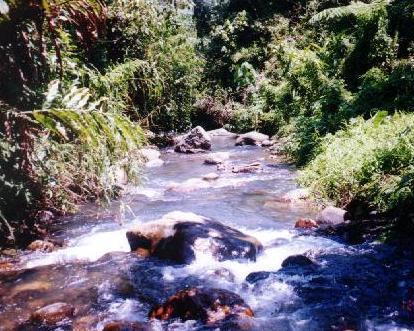|
Rain
Forests and Its Future

What comes into your
mind when you hear the word "rain forest?" I've asked several
people and some asked me in return, "is it the mineral water we're
drinking?" That sounds funny… but that's how they reacted. Grolier
defines rain forest as "a dense evergreen forest occupying a tropical
region with an annual rainfall of at least 100 inches."
The tropical rain forests have a constantly warm and rainy climate. It's
annual rainfall averages from 1,500 to 2,500 millimeters. They are actually
the cool rain forests in the middle of the latitudes. They also have heavy
rainfall, however, their climate is much lower than that of the tropics.
Locations
If we try to review our Geography back in High School, can we still
recall where most of the rain forests are located? The largest areas of
rain forest are in the lowlands of equatorial Africa and Amazon River Valley
of South America. There are other tropical rain forests in Central America,
in Southeast Asia, in Northeastern Australia, and on the islands of Indonesia.
Most of the tropical islands of the world have rain forests on their rainy,
windward sides. Cool rain forests are found along the northwestern coast
of North America, in southeastern Australia, in New Zealand, and in southern
Chile. Small areas of cool rain forest cover some mountain slopes in regions
with a wet climate.
What are Tropical Rain Forests?
Trees in tropical rain forests are green all year. Many kinds of trees
grow there. The wood of some trees is too heavy to float in waters. The
wood of others, like the balsa, whose wood is used in model airplanes is
very light. The trees grow close together and reach the height of 30 meters
(about 100 feet) or more in their competition for sunlight. The different
species are widely scattered. There are no forests of only one kind of
tree, such as the pine forests of the middle latitudes.
Moreover, the true rain forest the green foliage of the branches and treetops
spreads out like a huge umbrella to shade the forest floor. Long vines
called lianas hang from the tree branches and trunks. Molds, bacteria,
and insects attack fallen trees and leaves, causing them to decay rapidly
in the hot, damp climate. Because the climate is hot and wet all year,
the forest does not change much in appearance from one season to the next.
Along the borders of the rain forest and in places where people have cleared
the forest, more light reaches the ground, and there is a dense undergrowth
of shrubs, ferns, and grasses. This tangle of vegetation is what we call
jungle.
Animal life in the tropical rain forest is as varied as the plant life.
Monkeys and many species of birds and insects live in the treetops. Their
food comes mainly from the fruits and seeds of the forest. In the forest
of Africa and Asia there are large apes. Reptiles, birds and such animals
as the anteater and the jaguar eat other animals or insects. Only in the
grasslands bordering the forest are there many large grazing animals.
What lies ahead?
For centuries white people knew little about tropical rain forests.
They considered the forests barriers to civilization. It was only recently
when they begun to learn about the tropical diseases and learn how to live
in a hot climate and use the forests. They have also learned much from
the native people. Both the tropical and the cool rain forests have valuable
timber trees. Some fertile lands could be made to grow more food and fiber
crops, although trees are still the best crop for tropical soils. There
are probably minerals still undiscovered in these forest lands. With modern
machinery and scientific methods, people will make better use of the resources
of the rain forests in the future (H. J. Critchfield, WWU, 1984).
"Let us bear in mind that whatever destroys our environment,
destroys us as well."
|
Hazel
Glenda C. Guerrero is the Community Development Editor of VOICE,
Notre Dame of Dadiangas College Official Organ in 1993-1995, a Project
Officer and Environmental Management Researcher in Department of Agriculture,
South Cotabato, Sarangani and General Santos City, (SOCSARGEN) Project
Management Unit, Area Development Project, General Santos City. Presently, she is the School Director and Chief Operations Officer of AMA Computer College - General Santos City. You can
reach her via e-mail at:Hazelleglen@mailcity.com
Dr. Vitaliana
Cabatingan Guerrero is Doctor of Philosophy, Major in Educational Management,
Professor in Mindanao State University and a consultant who also contributed
to this article.
"Cool
rain forests, like those found in the tropics, have dense growths of trees
covered with mosses, ferns and vines. On the other hand, some of the trees
lose their leaves during winter season. Fallen trees decay slowly. Many
lie for several years, cluttering the dark forest floor. Animal life in
the cool rain forests varies greatly. The rain forest on the western coast
of North America has deer, elk and deers. In southwestern New Zealand there
were no mammals until people from Europe brought them in."
"According
to Critchfield, both the tropical and the cool rain forests have a sparse
population. Many groups of people in the tropical rain forests live by
hunting and fishing. They also gather fruits and nuts in the forest. Their
tools are simple, and they use such weapons as bows and arrows or blowguns.
They need few clothes in the hot climate. Usually the forest hunters live
in small villages. They move frequently to new areas in search of food.
Their houses are of wood with roofs of grass or leaves. Some tribes of
Indians in Brazil have large houses in which several families live. The
Pygmies of the Ituri rain forest in Africa live in small shelters and move
to new encampments from time to time."

|
![]()
![]()